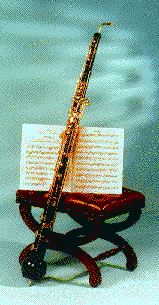Heckelphones
The Heckelphone is a woodwind instrument with the fingering of an oboe, pitched an octave lower (it is about 4 feet long), descending to the bottom of the bass clef (low A). It is similar to a bass oboe (aka baritone oboe or baryton oboe), but has a wider bore. The "general rule" for increasing the bore width when making a bass version of an instrument is to double the cross-sectional area of the bore for each octave down. The Heckelphone has a bore twice the diameter of an oboe bore.
The bell is generally vented on the side, with the bottom of the bell terminating in a peg, for supporting the instrument on the floor. The bell is bulbous for resonance.
It is played with a reed which resembles a small bassoon reed, fastened to a bocal much like an English Horn.
The Heckelphone was first released in 1904 by Wilhelm Heckel GmbH (the Heckel bassoon manufacturers), which still manufactures it by special order.

There is also a piccolo Heckelphone, which is pitched in F an octave above the English Horn (a fourth above the oboe), and a terz Heckelphone pitched one tone lower in Eb. These smaller Heckelphones, unfortunately, have not been made for some years. Apparently, only one Eb Heckelphone was ever made.

The Sound
The Heckelphone is broader and more robust than the bass oboe, which tends to sound thinner and more reedy by comparison. Some commentators have opined that even where composers have indicated the bass oboe, the Heckelphone was actually intended. Some of the Repertoire selections here are indicated as "bass oboe": there is some disagreement as to the composer's actual intentions...
The Repertoire
There are solo parts written for Heckelphone in Richard Strauss's Salome, and Elektra, as well as his Alpensymphonie and Josefslegende. Hindemith's Op. 47 Trio for Viola, Heckelphone and Piano is one of the best works composed for the instrument (or for viola, for that matter). Other works with Heckelphone parts include: Dollar Symphony in C Minor by Kurt Atterberg, Symphony No. 1 by A. Bax; "Fennimore and Gerda", "Paris", and the Dance Rhapsody by F. Delius; "The Planets" by G. Holst; "Sonnengeist" by R. Klose; 3rd Symphony in F by Franz Moser; "Moloch" and "Mona Lisa" by Max Schillings; the London Symphony by W. Vaughan; and the Symphony No. 3 by F. Weingartner. For the full list, see Peter Hurd's Heckelphone/bass oboe Repertoire
Reprinted with permission.
Written by Grant D. Green for http://www.contrabass.com
Copyright �©1995-2000 by Grant D. Green<